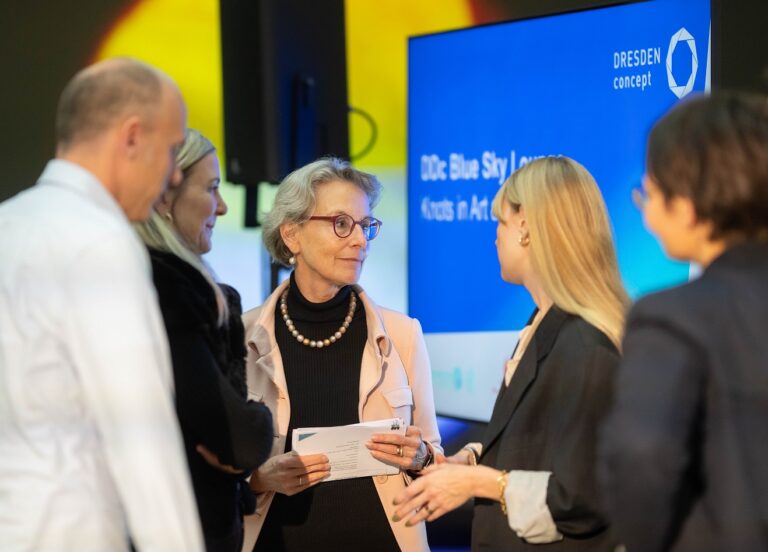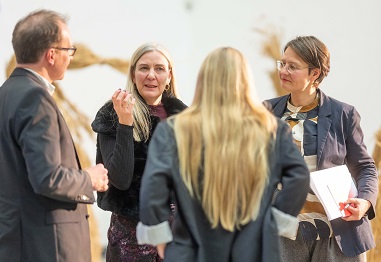Flashback DDc Blue Sky Lounge 2024
15.11.2024
 © Ronald Bonss
© Ronald Bonss
The Lipsiusbau in Dresden is an impressive building in the middle of Dresden’s old town. During the day, Dresden’s citizens and guests can visit the current special exhibition “Change will come” by the Dresden State Art Collections (SKD). The exhibition shows works by contemporary Polish artists and poses key questions about the relationship between art and society.
On the evening of November 13, 2024, the exhibition remained open to invited guests of the DDc Blue Sky Lounge. This annual event brings together scientific and cultural leaders from the DRESDEN-concept network with 40 partner institutions, thereby strengthening the links between the institutions. In discussions with selected speakers on interdisciplinary topics, participants receive impulses for new innovative research approaches.
The DDc Blue Sky Lounge took place for the third time this evening. Following Tasting and Smelling – a Culinary Science Evening in the Ernemannturm of the Technische Sammlungen Dresden) and Places and origins of our memory banks in the city archive of Dresden, this time the DDc Blue Sky Lounge was dedicated to knots in science and art. Maria Isserlis, the curator of the current exhibition in the Lipsiusbau, was invited to host the evening.
Knots in Art and Science
The idea of an interdisciplinary exchange on knots goes back to a get-together at the Max Planck Institute of Molecular Cell Biology and Genetics (MPI-CBG) around a year and a half ago. It was there that Professor Stephan Grill, Director and Research Group Leader at the MPI-CBG, and Professor Marion Ackermann, Director General of SKD, met and got talking about knots: We encounter knots across scientific disciplines and they are always an expression of complexity. They cannot be solved using familiar methods: new approaches are needed to solve them, and it was precisely this aspect that made the topic suitable for the next DDc Blue Sky Lounge.
Professor Ackermann and Professor Grill were joined by Professor Axel Voigt, Dean of the Faculty of Mathematics at TUD, and Professor Doreen Mende, Head of the Research Department at SKD. Four leading experts from the fields of mathematics, biophysics and art were thus recruited for the evening, creating an evening full of exciting and unexpected perspectives on knots.
Professor Ursula M. Staudinger, Chairwoman of the Board of DRESDEN-concept e. V. and Rector of the TUD, highlighted in her welcoming address the versatility of knots, which have both extremely negative and extremely positive associations and range from our shoelaces in everyday life to the scientific concept of knots and their application in art and science.
Marion Ackermann kicked things off with a concise presentation of knots in art across eras and cultures. Axel Voigt explained that knot theory is a branch of mathematics, more precisely a field of research in topology. Stephan Grill built directly on his colleague’s mathematical explanations and brought along exhibits from the Cluster of Excellence ct.qmat to illustrate topology: a hairy plush ball and a hairy plush donut. The researcher uses a comb to demonstrate the difference, as he is unable to comb the ball without twirling, despite his best efforts, but has no problem combing the donut. Finally, Doreen Mende presented the knot theory as a model for thinking about artistic imagination. Knots were already being used in the Renaissance as a technique for imagining perfection and infinity.
With these inputs, the guests were invited to deepen their new impressions of the evening with discussion partners from science and culture. Such a broad spectrum of knowledge and interests is extraordinary and an expression of the special networking of 40 partner institutions in the DRESDEN-concept.











